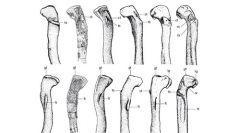

 Geodiversitas
28 (4) - Pages 649-684
Geodiversitas
28 (4) - Pages 649-684Eucoelophysis baldwini Sullivan & Lucas, 1999 is represented by several postcranial elements from the Petrified Forest Formation (Norian), New Mexico, USA. Eucoelophysis Sullivan & Lucas, 1999 was widely considered as a coelophysoid dinosaur by several authors, but the hindlimb anatomy of this genus clearly indicates that it belongs to neither of these groups. The following features exclude Eucoelophysis from Neotheropoda: absence of oblique ligament groove on caudal surface of femoral head, femoral medial epicondyle small and smoothly rounded, absence of caudal cleft between medial part of the proximal end of the tibia and fibular condyles, cnemial crest low, and fibular crest absent. Moreover, Eucoelophysis lacks dinosaurian synapomorphic characters, but has a plesiomorphic slightly inturned femoral head that prevents its assignment to Dinosauria. Interestingly, the morphology of the femur of Eucoelophysis is extremely similar to that of the basal dinosauriform Silesaurus opolensis Dzik, 2003 from the Late Triassic of Poland. In order to determine the phylogenetic position of Eucoelophysis, a cladistic analysis was carried out, which depicts Eucoelophysis as a non-dinosaurian dinosauriform. Thus reinterpreted, Eucoelophysis constitutes the youngest record of a non-dinosaurian dinosauriform, indicating their survival into the Norian, being co-eval with early dinosaurs.
Dinosauriformes, Coelophysoidea, Eucoelophysis, Chinle Group, Upper Triassic, New Mexico